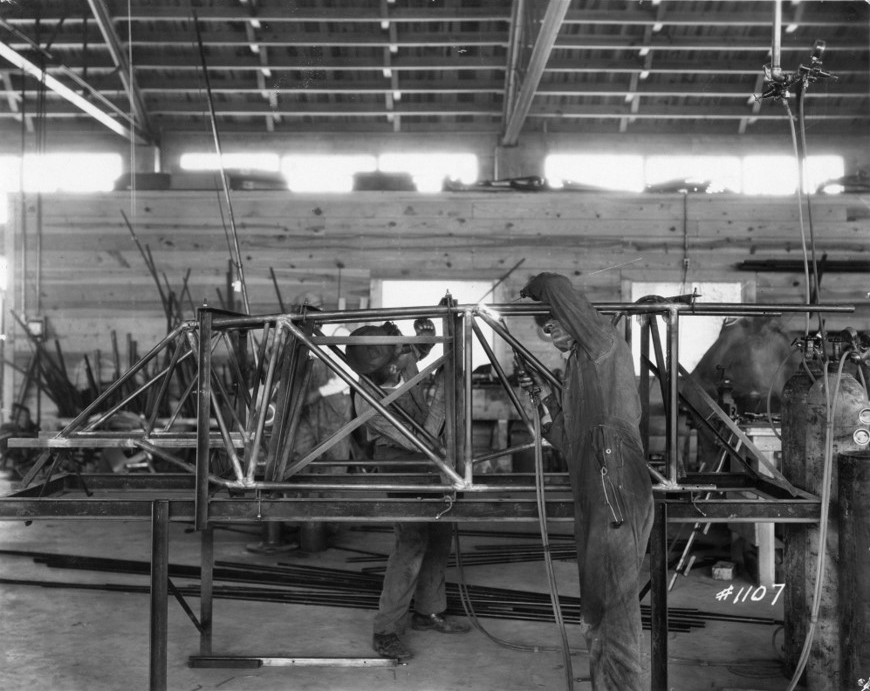Of all the employees at the Travel Air Company during its five-year existence, none were as deeply involved in the day-to-day management of the production line as was William “Bill” Snook, factory manager. A long-time resident of Wichita, Snook had worked at E.M. Laird’s “Swallow” airplane company after World War I, and following his years with Walter Beech at Travel Air, he went to work across town for pioneer aviator Clyde V. Cessna.
Although little is known (at least that can be verified) about production and technical upgrades made to the earliest Travel Air biplanes built between 1925-1927, Bill Snook kept a detailed record of production activity from 1928 until the company fell victim to the Great Depression in 1931 and closed its doors. By that time, however, Travel Air had already lost its true identity in 1929 when it became a subsidiary of the giant Curtiss-Wright aeronautical colossus.

The “Snook Book,” as it is known, contains the best and essentially the only source of reliable information about production of Travel Air airplanes – information that does not always agree with “hearsay history,” nor does it always align itself well with official FAA records residing in Oklahoma City, Okla. What makes Snook’s record-keeping so valuable to Wichita’s history and Travel Air enthusiasts is its brief chronology of each airplane as it was produced, including what types of ships were on the assembly line each day, their original engines, who the customer was and when they took delivery.
According to Snook, when he began his record keeping in February 1928, Travel Air had already built and delivered 223 airplanes, chiefly biplanes along with a smattering of Type 5000 cabin monoplanes (the Type 6000 monoplane was under development and would not make its first flight until April 1928).

The first airplanes Snook records in his production ledger include constructor numbers (c/n) 326, 328 and 329 that were being “set-up from storage” and assembled for flight testing. In addition, c/n 345, 346, 348 and 349 had recently been delivered (or “shipped out” as Snook called it) to a Travel Air dealer. An excellent example of Snook’s attention to detail centers on c/n 361, the last of four Type 7000 cabin biplanes built by the company. The first three were constructed in 1926 through 1928, with the final version (c/n 361) entering the production process on March 10, 1928.

As with its predecessors, the fourth Type 7000 was powered by a Wright Aeronautical nine-cylinder J5 static, air-cooled radial engine rated at 200 hp. The biplane, which had a maximum speed of 107 mph, featured a cabin that could seat up to four people or carry hundreds of pounds of mail. In fact, Snook made a note in his book that the airplane was built as a “cabin mail job” and may have been delivered without any passenger seats installed. Although company engineers completed an extensive stress analysis of the 1928 Type 7000 (copies of which still exist at the Wichita State University Library), no Approved Type Certificate was issued by the Department of Commerce (DOC).

Another example of the book’s historical value is c/n 380 and 381, which Snook noted were equipped with Siemens-Halske radial engines rated at 125 hp. Travel Air conducted flight tests of the engine late in 1927 and only two airplanes are known to have been built with this powerplant. The first may have been c/n 380, registered with the DOC as “3791” and designated as a Travel Air Type 9000. Although generally known as a reliable engine, the Siemens-Halske was expensive and proved to be less popular than the Warner “Scarab” and later Wright J6-7 “Whirlwind” engines. As of 2020, no Type 9000 is known to exist. If anyone has documentary evidence or DOC confirmation that their ship was (or is) a Type 9000, please contact me at edwardhphillips@yahoo.com.

Here are a few more examples of interesting notes jotted down by Snook as 1928 progressed. In March he noted that c/n 401 “Went to Gerbracht with J-5 engine.” Gerbracht was a Travel Air sales agent but the actual customer is unknown. Later that week he wrote that c/n 395 was shipped “without engine,” while another notation verifies that the first Type 6000 cabin monoplane was c/n 230, registered as “X4765” (it led a turbulent life and later was destroyed by fire).

In April 1928 Snook noted that c/n 427 and 428 were powered by Hispano-Suiza upright, V-8 engines and sold into Mexico, while c/n 146, probably built in 1926 and still operating in the Boston, Mass., area, was back at the factory for “repairs.” There are also a number of mystery notations throughout the book that are as yet unexplained, such as the mention of three ships, c/n 464, 465 and 466, that were reportedly equipped with the Siemens-Halske engine, but there is no known evidence to support that claim in FAA records. Another Type 9000 (c/n 421), however, is noted by Snook in June 1928.
The oldest Travel Air recorded in the book is c/n 144, which probably belonged to businessman “Skipper” Howe (Howell?) of Wichita. It was the first airplane equipped with the new Wright J-4 radial engine that transformed the Model “A” into the Type BW that evolved into the Type 4000. Howe (Howell) took delivery of the ship in 1926.
There are many more historically important notes in the “Snook Book,” but space does not allow me to include them all here (perhaps more can be featured in a future article). I am glad to share what information is available if it will assist someone in tracking down the recorded origins of their airplane.

 Back
Back